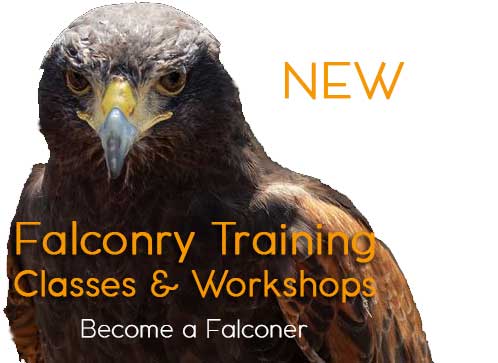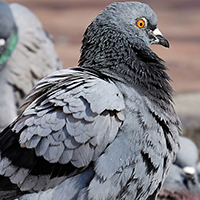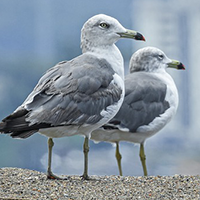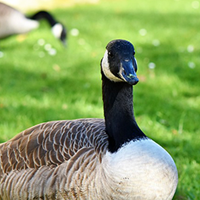 Without a doubt, Bird Control is of utmost importance around airports, as the toll on human life as well as aviation equipment is potentially huge. Bird strikes on aircraft has the potential to cause significant damage and possible catastrophic events. Bird strikes are a dangerous threat to aviation safety, particularly on take off and landing. The consequences of a goose hitting an engine or the windshield of an aircraft can be disastrous. Bird strikes can cause engine failure, damage to critical structures, and even crashes. Given the seriousness of the possible consequences, many airports in North America and in Europe use falconry as an effective method of deterrence.
Without a doubt, Bird Control is of utmost importance around airports, as the toll on human life as well as aviation equipment is potentially huge. Bird strikes on aircraft has the potential to cause significant damage and possible catastrophic events. Bird strikes are a dangerous threat to aviation safety, particularly on take off and landing. The consequences of a goose hitting an engine or the windshield of an aircraft can be disastrous. Bird strikes can cause engine failure, damage to critical structures, and even crashes. Given the seriousness of the possible consequences, many airports in North America and in Europe use falconry as an effective method of deterrence.
Why Choose Falconry for Bird Control at Airports
- Falconry used for bird abatement and wildlife management at airports is natural, ethical, humane and environmentally responsible.
- Falconry for bird abatement is highly effective for bird control as it uses the innate fear of birds to the predators - raptors.
- Specially trained raptors work in tandem with the expert falconer and closely follow signals and commands from the falconer.
- Many species of raptors are used to deter the many species of problem birds. Falcons will target smaller faster birds and eagles are used for the larger birds like geese.
- Raptors can fly at higher altitudes than any man can reach with other control methods.
The Benefits of Falconry for Bird Control around Airports:
The benefits of using falconry are myriad.
- Falconry is environmentally friendly, no chemicals or pollutants to harm the environment.
- Falconry is highly effective. The presence of raptors is a very strong deterrent for almost every bird species.
- Falconry is highly adaptable. The falconry program is tailored to each airport and the environment. It can be quickly adapted as needs change, especially during migration in spring and fall, when differing species of bird may fly through the area. The presence of raptors is a very strong deterrent for almost every bird species.
- Falconry is very cost effective after the initial expenditure. It will lead to long term savings by reducing and minimizing the cost of bird strikes and damage to the aircraft, reducing downtime and repairs to the aircraft. The extent that bird strikes can be minimized is truly amazing. For example: A southern US airport had a trial program for the month of January a few years ago. Bird strikes went from 161 a month to 1 bird strike.
How Falconry at Airports works:
Airport Assessment and Planning
In order to use falconry at an Airport Assessment and planning must to done on a continuous basis. Wildlife control experts assess the bird activity at the airport, what species of bird and other wildlife is present, the behaviour patterns of the birds and the wildlife, what in the area may be attracting the birds, and what can be modified in the habitat to make it less attractive to birds.
Selection of Bird of Prey
The selection of raptor(s) to be used is important. The larger raptors will go after larger birds, ie: Eagles are used for Geese, Falcons with their speed and agility will go after smaller birds like starlings or gulls, Hawks will be sent after smaller birds yet, like songbirds and doves. Owls can also be used, especially at dawn and dusk and in the colder weather. The choice of raptor is going to depend on the predominant species in the area. Often a variety of raptors are used.
Flying Birds of Prey
The raptors used at airports are highly trained and taught to stay out of the way of aircraft flight paths. The falconers must be exceptional at their craft and have a close relationship with their raptors. The continuous presence of raptors in the area makes it a hostile environment for birds and most smaller wildlife. Dogs and drones are also sometimes used in conjunction with falconry. Dogs and drones will scare away the larger wildlife and prevent any ground animals from making the area their home.
About Falconry
The ancient art of falconry has been used for thousands of years across various cultures around the world to hunt with a trained raptor in cooperation with the falconer. In the context of bird control at airports, falconry involves using highly trained raptors - including hawks, falcons, owls and eagles, to keep other problems birds away from the vicinity of an airport. Falconry for bird abatement uses the innate fear of the prey when a predator is in the area. The prey - problem bird species - will flee the area and tend to stay away because of the danger to them. The fear response to the predator is used to our advantage.
Falconry for bird control is a unique blend of using Mother Nature along with modern wildlife management strategies. Public perception of falconry is generally positive because it is humane, environmentally friendly and does not harm the ecosystems of the areas where the magnificent raptors are flying.
Other Bird Control Methods
Traditional methods of bird control include loud noises such as shotguns, pyrotechnics, sonic boom devices, visual deterrents like using reflectors that move with the wind, and habitat modification to make the area less attractive to birds. These methods all have their limitations. Birds become use to the noise and the lights and seeing no actual danger to them they become habituated to it. However, putting a raptor in the air becomes a serious threat to any birds near the airport.
Unique Challenges at Airports
One of the challenges of using falconry for bird control at airports is finding an expert falconer who has the skills and experience for assessment and planning, who knows behavioral patterns of different species of raptors as well as those of the problem birds, and has a sufficent amount of raptors on hand. Birds of Prey cannot work all day, everyday; many raptors are required to get the job done.
Hawkeye Bird & Animal Control
Hawkeye Bird & Animal Control are the experts at falconry around airports. Dan Frankian is a master falconer and trains his raptors to provide bird control on the apron and beside the runways while keeping the raptors out of the actual flight path. His Birds of Prey are specially trained to scare birds away from the flight path before the problem birds even approach it, from as far out as the outer marker. You don’t have to wait for the aircraft to land to have your raptor up in the sky.
Dan Frankian also teaches his methods to other falconers. If you have a team of falconers or a wildlife abatement team wanting further training, please contact Dan at Hawkeye Bird And Animal Control.
















